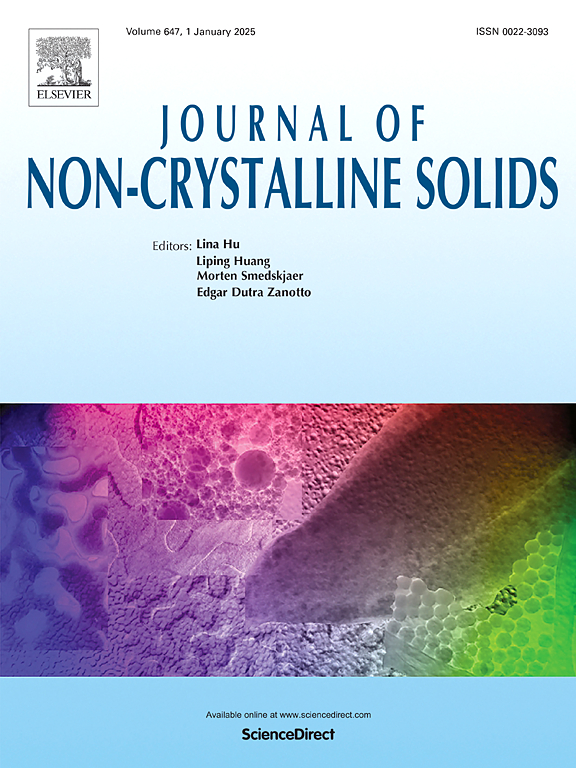Controlling the valence change of sulfur in glass during S K-edge XAFS measurements by conductive coating
IF 3.5
3区 材料科学
Q1 MATERIALS SCIENCE, CERAMICS
引用次数: 0
Abstract
Sulfur is an important multivalent element for tuning glass properties. Analyzing the valence state of sulfur in glass is essential as it significantly influences the glass characteristics. X-ray absorption fine structure (XAFS) is a powerful technique for elucidating both the valence state and structural attributes of sulfur. However, alterations in the valence of sulfur during XAFS measurements present significant challenges. This study explores a method to control valence changes during S K-edge XAFS measurements. By applying a carbon coating to the surface of glass samples to prevent charging, spectra that accurately reflect the original redox state of sulfur were obtained, which was confirmed by the following: (1) The XAFS spectra of carbon-coated glass samples showed reasonable peak intensities for S2− and S6+ compared to corresponding standard samples; (2) consistent spectra were obtained from repeated measurements at the same location; and (3) the peak intensity ratio of S2− to the sum of S2− and S6+ correlated well with the sulfur redox state determined by wavelength-dispersive X-ray fluorescence (WD-XRF). The extended measurement duration permitted by this technique also enabled the detection of small peaks at 2467 and 2469 eV in an amber glass sample, which are related to sulfide-proton (S2−–H+) and sulfide-ferric (S2−–Fe3+) bonds, respectively. Utilizing this method in conjunction with synchrotron light sources of increased brightness could further enhance the detection of such minor peaks and provide deeper insight into the structural characteristics of sulfur in glass and their influence on glass properties.
利用导电涂层控制k边XAFS测量过程中玻璃中硫的价态变化
硫是调节玻璃性质的重要多价元素。分析玻璃中硫的价态是必要的,因为它对玻璃的特性有重要影响。x射线吸收精细结构(XAFS)是研究硫的价态和结构属性的有力技术。然而,在XAFS测量期间,硫价的变化带来了重大挑战。本研究探索了一种控制S - k边XAFS测量中价态变化的方法。通过在玻璃样品表面涂覆碳膜防止充电,获得了能准确反映硫原始氧化还原状态的光谱,证实了这一点:(1)与相应标准样品相比,涂覆碳的玻璃样品的XAFS光谱显示出合理的S2−和S6+峰强度;(2)在同一位置重复测量得到一致的光谱;(3)波长色散x射线荧光(WD-XRF)测定的硫氧化还原态与S2−与S6+的峰值强度比具有良好的相关性。该技术允许延长的测量时间还可以在琥珀玻璃样品中检测到2467和2469 eV的小峰,它们分别与硫化物-质子(S2−-H +)和硫化物-铁(S2−-Fe3 +)键有关。将这种方法与亮度增加的同步加速器光源结合使用,可以进一步增强对此类小峰的检测,并更深入地了解玻璃中硫的结构特征及其对玻璃性能的影响。
本文章由计算机程序翻译,如有差异,请以英文原文为准。
求助全文
约1分钟内获得全文
求助全文
来源期刊

Journal of Non-crystalline Solids
工程技术-材料科学:硅酸盐
CiteScore
6.50
自引率
11.40%
发文量
576
审稿时长
35 days
期刊介绍:
The Journal of Non-Crystalline Solids publishes review articles, research papers, and Letters to the Editor on amorphous and glassy materials, including inorganic, organic, polymeric, hybrid and metallic systems. Papers on partially glassy materials, such as glass-ceramics and glass-matrix composites, and papers involving the liquid state are also included in so far as the properties of the liquid are relevant for the formation of the solid.
In all cases the papers must demonstrate both novelty and importance to the field, by way of significant advances in understanding or application of non-crystalline solids; in the case of Letters, a compelling case must also be made for expedited handling.
 求助内容:
求助内容: 应助结果提醒方式:
应助结果提醒方式:


